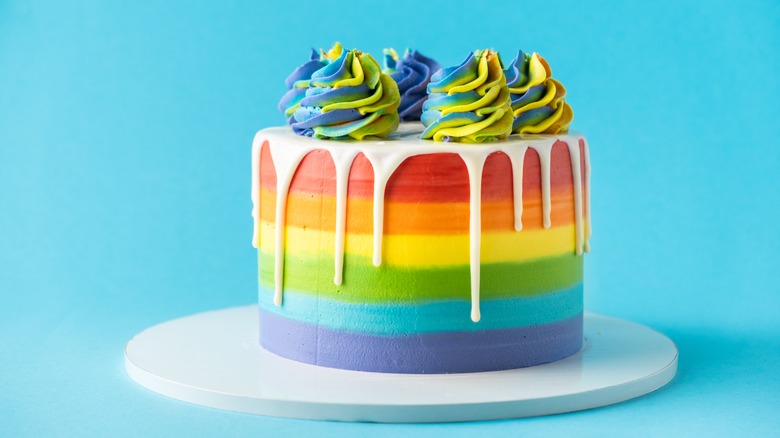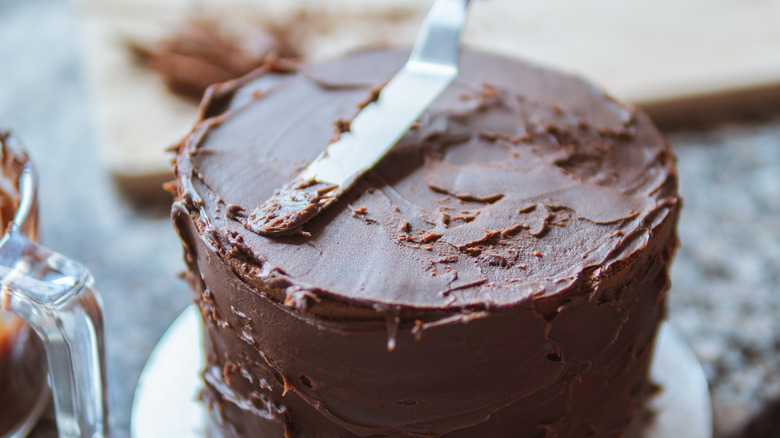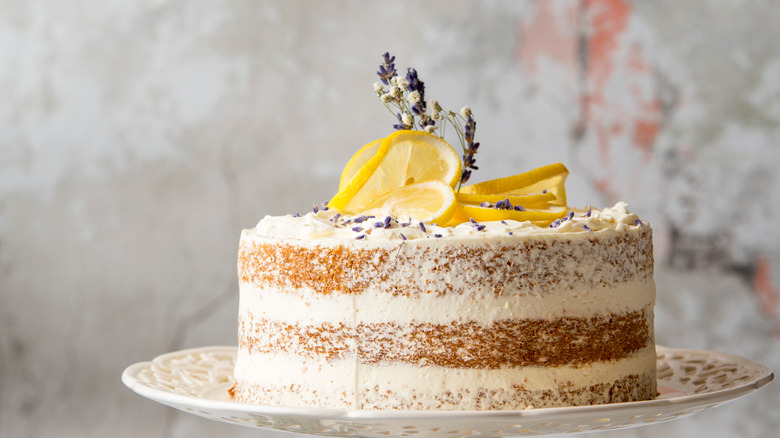What Is A 'Crumb Coat' And Why Does Your Cake Need One?
Home bakers may have a tough time achieving the tidy, gorgeous results of professional bakeries. While home bakers' lack of practice can be a downfall, there's so much more to icing a cake than simply spreading it on.
According to The New York Times, the pros have an arsenal of tools to make a perfect cake. They use a serrated knife, or cake leveler, to keep things even and sturdy. Off-set spatulas are ideal for spreading the icing. A rotating cake stand keeps you from performing the acrobatics of reaching every inch of the cake. And the parchment paper trick ensures a clean result.
Most importantly, the pros never skip the 'crumb coat', a thin, almost see-through, layer of icing that coats the cake before the final layer of frosting is added, according to Wilton. This step gives an even, level basecoat for the final decorative frosting. Most importantly, it locks the crumbs from the trimmed layers into place. Without this step, they will imbed themselves into the frosting for a crumby-looking cake.
Crumb coats aren't just needed, they're a necessity
For the best results, a crumb coat requires some time, according to MasterClass. To start, employ some cake hacks for level, trimmed, and fully cooled cake layers. The warm cake will melt the crumb coat, rendering it ineffective. You can use any spreadable icing like buttercream, and it doesn't have to be the icing that will be the final coat. Glazes, royal icing, and fondants are too thin, too sticky, or too thick for a crumb coat, per MasterClass.
After stacking the cake layers, keep the crumb coat frosting separate from the rest. Otherwise, you could absentmindedly add the excess crumb coat, with the crumbs, to the pristine icing for the final coat. Apply frosting to the top layer, spreading the extra over the edge, and use this to spread a thin layer around the cake. Make sure that this is perfectly smooth. Inspect the crumb coat to ensure that it's perfectly level and cover any low spots or cracks.
Finally, the crumb cake needs to harden to lock in those crumbs and provide the sturdiest base for the final icing. This can take as little as 30 minutes for the icing to become dry to the touch. An overnight chill in the refrigerator works, too.
What does your cake need after the crumb coat?
In some cases, a crumb coat is all you'll need. Brides explains how there's a popular trend called "naked cakes." The crumb coat is the final coat of icing. This rustic option certainly is a deviation from a typical wedding cake. Aside from a striking, minimalist aesthetic, a naked cake is perfect for folks who aren't that into frosting, icing, or fondant. The downfall is that because of the lack of a good icing barrier, these cakes can dry out quickly. So, they're best baked, prepared, and served on the same day.
If you're not into naked cakes and want the final layer of icing, King Arthur Baking's blog illustrates the entire process. The final layer of frosting follows the same procedure as the crumb coat but uses more icing. Start with the top and spread the excess icing over the edge and onto the sides of the cake. After that, you can add fondant, call it good, or start adding extra decorations. Don't forget the step that is essential to safely transporting a frosted cake, if needed.


